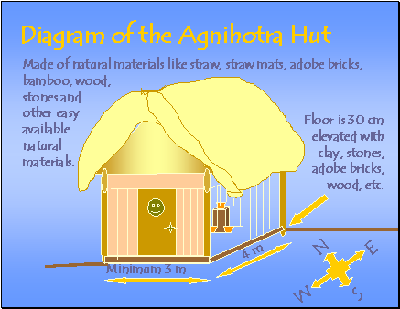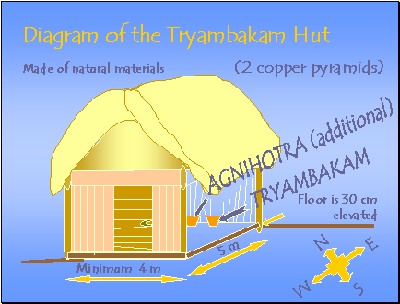A Resonance Point is a special arrangement of 10 pyramids which have been activated with Mantra. The Resonance Point is established on a Homa farm to magnify the power and increase the coverage of Agnihotra.
The Resonance Point Technique is a part of HOMA Therapy, where simple practices are used to heal bigger areas of diseased plantations in a short time. The same human effort is required to heal one or one hundred acres. Therefore one Resonance Point can be used to heal up to 200 acres of land.
For this, two simple huts are needed, built with locally available, economical and natural material, found in the area like: wood, adobe bricks, mats, bamboo, stone, cane, etc. Nobody will live there. They are simply to protect the person performing the healing fires of HOMA Therapy from the sun, rain and to prevent animals like dogs, cats, chickens, horses, etc. from entering. It should be quite inexpensive to build these huts or cabins.
Also four Resonance Columns are installed on the boundary of the farm in each of the four cardinal directions from the main Resonance hut.

Agnihotra Hut
One hut, the main hut or Agnihotra hut, is where the AGNIHOTRA fire is performed daily at sunrise and sunset. It is ideal to build this hut in the centre of the farm, if possible. Size should be approx. 3 x 4 meters, the longer side aligned with the EAST/WEST axis. Entrance has to be from the WEST and one will sit down facing EAST to do the fires.
Om Tryambakam Hut
This hut is to be little larger than the Agnihotra Hut (4x5m).  We call it the OM TRYAMBAKAM HUT. The fires are done for agriculture, yet the whole area becomes full of nutrients and a healing area is created for sick plants, animals and human beings. In this OM TRYAMBAKAM HUT or “HEALING HUT”, 2 pyramids are installed on small columns of mud. The one on the left is for AGNIHOTRA, and the one on the right is for OM TRYAMBAKAM HOMA.
We call it the OM TRYAMBAKAM HUT. The fires are done for agriculture, yet the whole area becomes full of nutrients and a healing area is created for sick plants, animals and human beings. In this OM TRYAMBAKAM HUT or “HEALING HUT”, 2 pyramids are installed on small columns of mud. The one on the left is for AGNIHOTRA, and the one on the right is for OM TRYAMBAKAM HOMA.
It is better to construct this hut near the entrance of the farm so that outsiders can come and go without disturbing the privacy of those who live and/or work on the farm.
You have to face EAST while doing HOMA
Resonance Pillars
There are four resonance pillars which are installed on the north, south, east and west points directly from the Agnihotra or “Resonance” Hut in the center of the farm.
To heal sick plants, to rejuvenate the earth and to improve the quality of the water, AGNIHOTRA should be carried out daily on exact schedule, given by computer according to the longitude and latitude of the specific farm, and besides a minimum of 4 hours of OM TRYAMBAKAM HOMA should be performed daily. On full Moon or new Moon, 24 hours or the most possible number of hours of OM TRYAMBAKAM HOMA should be performed. These guidelines are to be followed in order:
* to heal plants from fungi, bacteria, harmful insects, nematodes, weevils, viruses, etc.
* to control weeds
* to produce abundant and healthy crops.

